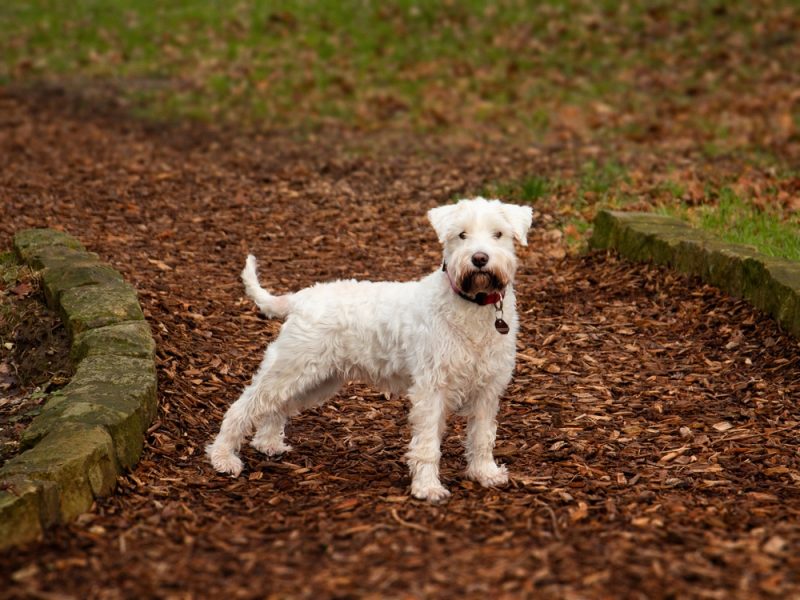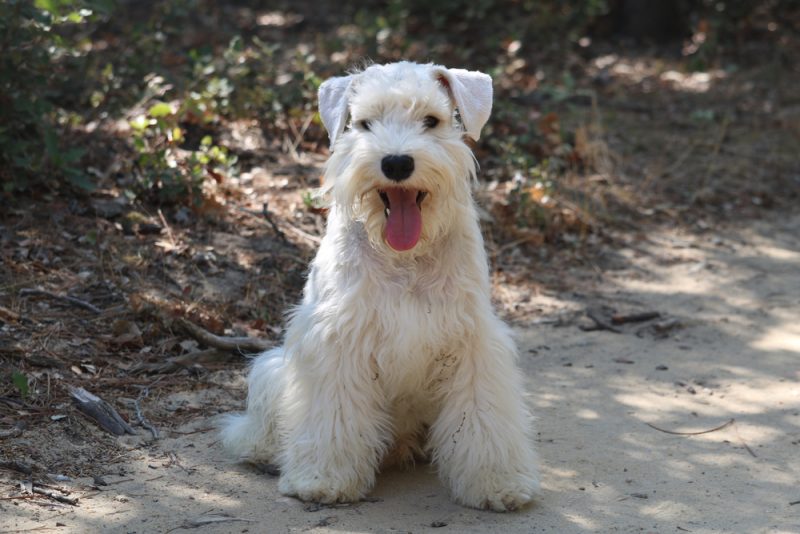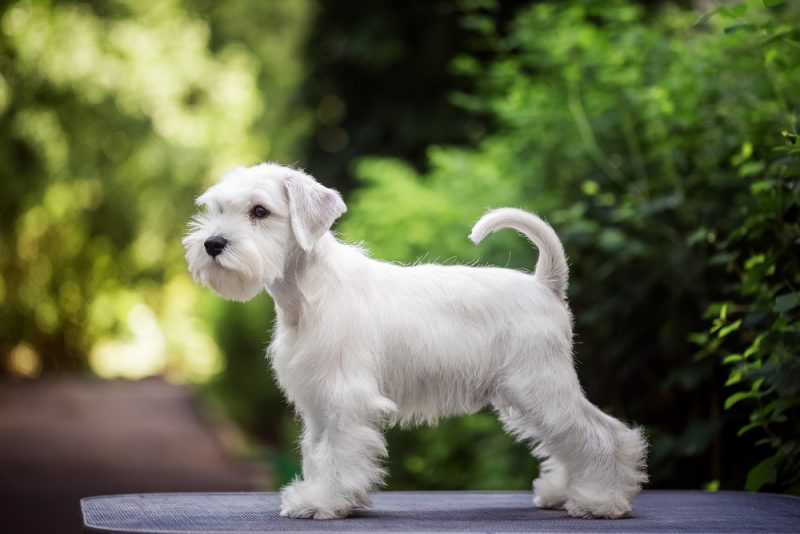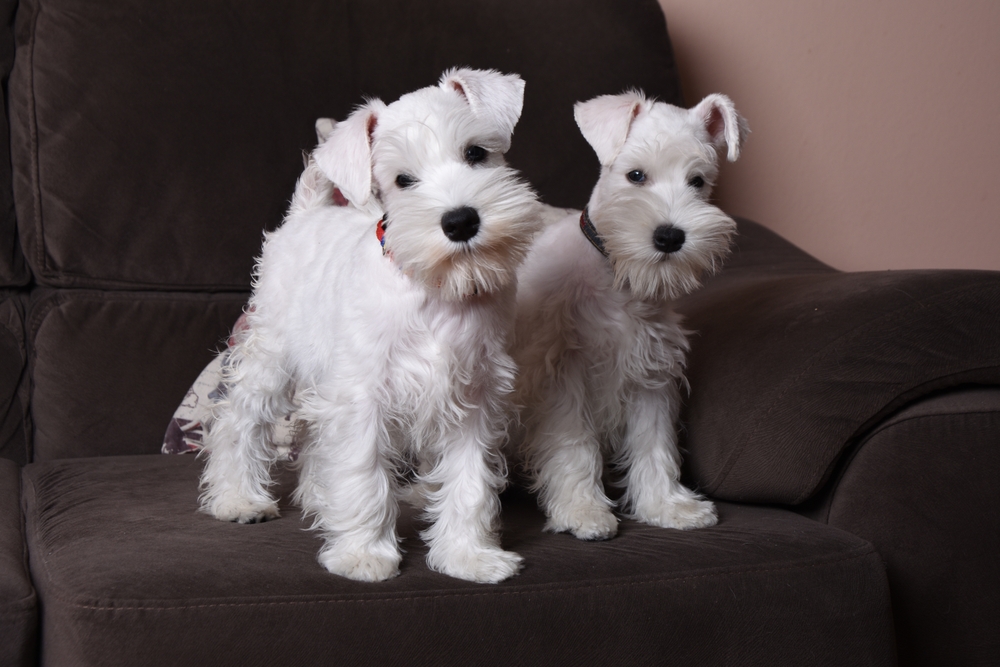The white Miniature Schnauzer is an unusual color variation of the popular small dog breed. While not common, interest in white Miniature Schnauzers is increasing, as it usually does for rare varieties. Keep reading to learn more about this miniature white Schnauzer dog breed, including their history and origins. You’ll also learn whether these beautiful dogs make good pets.
Breed Overview
Suitable for:
Individuals and families looking for a friendly, easily trained, playful dog
Temperament:
Intelligent, obedient, friendly, playful, good with kids and other pets
Besides their color, white Miniature Schnauzers display the same personality and physical traits as other variations of the breed. Don’t be fooled by breeders who claim white Miniature Schnauzers are a “new” or separate breed. In case you were curious, you should know that unlike the three other Schnauzer colors (more on this later), only Minis come in white. Standard and Giant Schnauzers don’t show this lighter color.
White Miniature Schnauzer Characteristics

The Earliest Records of White Miniature Schnauzers in History
The Miniature Schnauzer breed was developed in Germany in the late 1800s as a smaller version of the popular working dog, the Standard Schnauzer. Part of the Standard Schnauzer’s job was to hunt rodents for farmers. However, the farmers developed the Miniature Schnauzer to track rats more effectively in tight spaces.
To develop the Miniature Schnauzer, early breeders crossed Standard Schnauzers with Poodles, Affenpinschers, and Miniature Pinschers. White Miniature Schnauzers were among the colors first noted in the breed. The earliest record of a Miniature Schnauzer comes from 1888, so it’s likely that the first white dogs also appeared around this time.
However, early breeders chose to focus on producing colors that matched those found in the Standard and Giant Schnauzers, and white wasn’t one of them. Because of this, white Miniature Schnauzers weren’t deliberately bred during the developmental phase. White Miniature Schnauzers continued to exist but were considered rare.

How White Miniature Schnauzers Gained Popularity
Bred initially as a small working dog, the charming personalities of the white Miniature Schnauzer eventually led them to become more of a pet and companion animal. From Germany, the Miniature Schnauzer spread across Europe and to America in 1924.
Although they reached America in the 1920s, the Miniature Schnauzer’s popularity really took off after World War II. However, white Miniature Schnauzers did not maintain the same popularity as other colors.
As we’ll discuss further in the next section, American and Canadian breeders continued to focus on the standard Schnauzer colors instead of white. Today, the white Miniature Schnauzer is experiencing increased popularity thanks to breeders marketing it as a “rare” and unique version of this well-known breed.

Formal Recognition of White Miniature Schnauzers
In Germany, the Miniature Schnauzer was officially recognized as a separate breed from the Standard in 1899. The American Kennel Club (AKC) made the Miniature Schnauzer official in 1926. An American Miniature Schnauzer Club was formed shortly after, in 1933.
White Miniature Schnauzers are not an officially recognized color by the AKC or equivalent associations in the UK and Canada. However, they are recognized by European countries that are part of the Federation Cynologique Internationale (FCI.) The FCI includes “white with a white undercoat” in the official Miniature Schnauzer breed standard, adopted in 1955.
White Miniature Schnauzers can participate in FCI shows and be purchased from reputable breeders across Europe. They are barred from official shows in the United States, and most reputable Miniature Schnauzer breeders don’t produce white dogs.


Top 3 Unique Facts About the White Miniature Schnauzer
1. They Are the Only Terriers Without British Origins
The AKC includes Miniature Schnauzers in the Terrier group for show purposes. All other members of this group were either developed in the UK or from breeds with British origins. This fact may explain why white Miniature Schnauzer personalities differ from typical Terriers.
2. White Is One of Four Colors Represented in the Miniature Schnauzer
As we mentioned, the FCI includes white as an official breed color. Other purebred dog associations, like the AKC, only recognize the following three colors:
- Black
- Black and silver
- Salt and pepper
3. The Smallest Schnauzers Are the Most Popular
Schnauzers come in three sizes: Giant, Standard, and Miniature. Of the three, Miniature Schnauzers are by far the most popular. At one point, Miniature Schnauzers were the third most popular breed in America. They currently rank in the top 20 of all registered breeds.


Does a White Miniature Schnauzer Make a Good Pet?
Miniature Schnauzers of all colors are so popular because they make wonderful pets for almost any living situation. Their size allows them to live in apartments or other small spaces, although they tend to bark a lot. White Miniature Schnauzers generally get along with all family members, from kids to other pets.
They are smart, eager to learn, and affectionate with their family. However, White Miniature Schnauzers are not automatically friends with everyone they meet but make good watchdogs. They take time to get to know strangers before accepting them.
The white Miniature Schnauzer’s coat requires regular grooming or stripping to keep it healthy. However, they don’t shed much and may be a good choice for people with allergies.
Miniature Schnauzers are generally a healthy breed with few inherited health conditions. However, at least in the U.S., white Miniature Schnauzers are sometimes produced by irresponsible breeders who prioritize color over avoiding inherited medical issues. It’s vital to research the breeders in your area carefully before purchasing a puppy.


Summary
If you aren’t interested in breeding or showing your dog, there’s no reason to avoid a mini white Schnauzer if you find the color appealing. You’ll probably need to be extra picky about selecting a breeder who produces healthy dogs rather than simply breeding for a rare color. Because white Miniature Schnauzers can be registered in many parts of Europe, breeders in those areas are likely to have quality dogs. However, buying from the other side of the world is probably impractical for most owners.
Featured Image Credit: Pawparazzi88, Shutterstock
